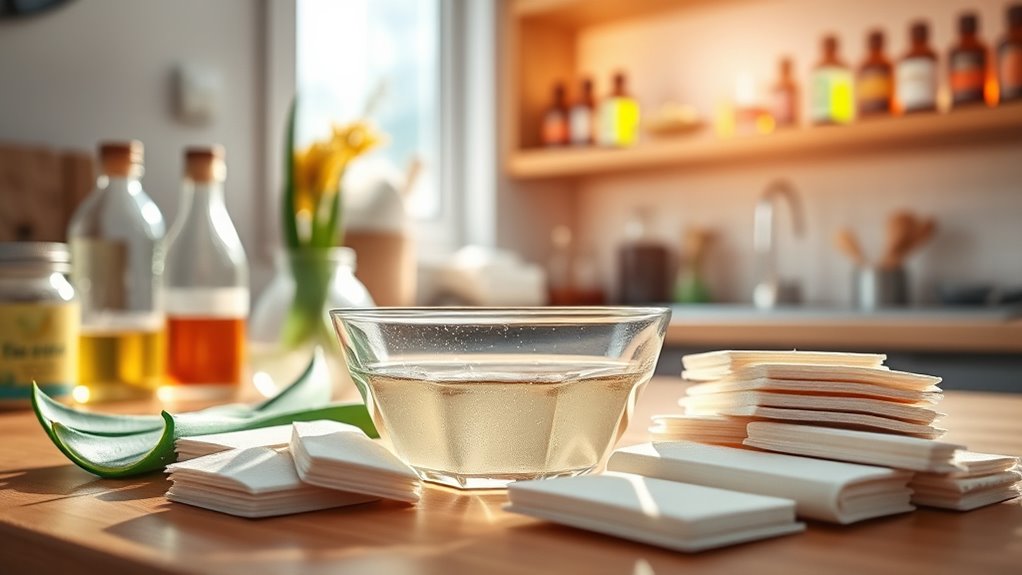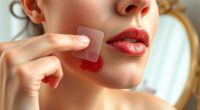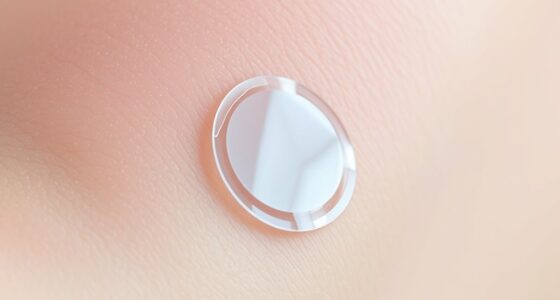To rescue your skin from pesky pimples fast, try making effective homemade patches. Use hydrocolloid bandages to absorb fluid and promote healing. For a natural alternative, mix 1 part apple cider vinegar with 2-4 parts water for a soothing spot treatment. You can also freeze green tea to create ice cubes for inflammation relief or whip up a baking soda paste to unclog pores. Interested in more remedies to enhance your skincare routine? Keep exploring!
Key Takeaways
- Create hydrocolloid patches using adhesive bandages, cutting them to size for a protective barrier over blemishes.
- Mix diluted apple cider vinegar as a spot treatment to reduce bacteria and promote healing on acne spots.
- Make green tea ice cubes by freezing brewed green tea, then use them to soothe inflammation and redness on the skin.
- Combine baking soda with distilled water for a paste that unclogs pores and can be used as a mask for 10-15 minutes.
- Blend tea tree oil with aloe vera gel for a natural remedy that fights bacteria while soothing and hydrating the skin overnight.
Effective Hydrocolloid Bandage Patches

When you’re dealing with acne, effective hydrocolloid bandage patches can be a game changer. These patches contain gel-forming agents that absorb excess fluid from your pimples, creating a protective barrier that promotes healing. By maintaining a moist environment, they help reduce inflammation and speed up recovery. Plus, they shield your blemishes from contaminants and irritation, preventing further trauma. Hydrocolloid patches are particularly useful for mild to moderate acne, especially for pustules and papules. They’re thin, flexible, and waterproof, making them convenient for day and night use. You can even cut them into various shapes to fit different blemishes. With these patches, you’ll find a cost-effective solution for clearer skin without the hassle. Additionally, their absorbing properties enable healing in a sealed, moist environment, preventing scarring. Many of these patches also contain salicylic acid to enhance their effectiveness against stubborn acne.
Soothing Apple Cider Vinegar Solutions

Soothing apple cider vinegar solutions offer a natural and effective way to tackle acne. Its antibacterial properties help combat *Cutibacterium acnes*, making it a great choice for your skincare routine. For a simple toner, dilute 1 part apple cider vinegar with 2 to 4 parts water, adjusting based on your skin sensitivity. You can also create a spot treatment by applying the diluted mix directly to pimples for 5 to 10 minutes. For a deeper cleanse, combine apple cider vinegar with bentonite clay to form a mask that balances pH levels and smooths your skin. Additionally, maintaining skin hygiene through regular washing of pillowcases can further enhance your acne-fighting efforts. Just remember to patch test before applying it widely, and always follow up with a moisturizer for ideal results.
Green Tea Ice Cubes for Inflammation Relief

If you’re looking for a simple yet effective way to reduce inflammation and soothe irritated skin, green tea ice cubes might be your new go-to remedy. Packed with antioxidants, these ice cubes help neutralize free radicals and calm redness, making them perfect for acne-prone skin. To make them, just steep green tea bags in boiling water for 7-8 minutes, cool the mixture, and freeze it in an ice cube tray. When you’re ready to use, gently rub a cube over your face or specific areas like pimples and under-eye bags. For enhanced benefits, try adding honey or cucumber during preparation. Additionally, these ice cubes can improve blood circulation, which further aids in healing the skin. Remember to use them within two days for the best results and always patch test for allergies!
Baking Soda Paste for Pore Cleansing

After exploring the calming effects of green tea ice cubes, you might want to try another natural remedy for acne: baking soda paste.
This simple recipe combines 2 teaspoons of baking soda with distilled water to create a paste. Apply it directly to your acne or massage it onto your skin. Leave it on for 10-15 minutes if you’re using it as a mask, or rinse immediately for exfoliation. Baking soda is an alkaline substance that helps manage pH levels, making it a popular choice for those seeking clearer skin. Additionally, maintaining a balanced diet rich in dietary fiber can support overall skin health.
Use this treatment no more than twice a week to avoid irritation. While baking soda can help unclog pores and improve skin texture, be cautious, as it may disrupt your skin’s pH balance and cause dryness.
Always follow up with a moisturizer to keep your skin hydrated.
Tea Tree Oil and Aloe Vera Combo

Harnessing the power of tea tree oil and aloe vera can be a game-changer in your battle against acne.
Tea tree oil’s antibacterial properties effectively combat acne-causing bacteria, while its anti-inflammatory effects reduce redness and swelling. Additionally, acne can lead to scarring if not treated properly, making this combination even more important for maintaining skin health. It is crucial to ensure that you dilute oils properly before applying them to the skin to prevent irritation.
Aloe vera gel soothes and hydrates your skin, packed with essential vitamins that promote overall health. To create this powerful combo, mix 12 drops of tea tree oil, 2 tablespoons of aloe vera gel, and ½ teaspoon of argan oil in a cool, dark place.
Apply it to clean skin at night, and rinse with warm water in the morning for best results. This natural, budget-friendly remedy not only targets blemishes but also enhances your skin’s overall well-being.
Frequently Asked Questions
How Often Should I Use Homemade Pimple Patches?
You should use homemade pimple patches as soon as you notice a breakout.
Ideally, leave them on for several hours, or overnight, for the best results. The frequency depends on how severe your breakouts are and your skin type.
Always clean the area before applying a new patch to maintain hygiene, and consider using a moisturizer to prevent dryness, especially if you have sensitive skin.
Can I Use These Patches on Sensitive Skin?
Yes, you can use these patches on sensitive skin, but you need to be cautious.
Always perform a patch test to check for reactions. Opt for gentle, non-irritating ingredients like aloe vera and raw honey. Avoid anything harsh, like undiluted tea tree oil.
Verify your preparation area is clean to prevent contamination, and monitor your skin’s response closely after applying the patches. If irritation occurs, discontinue use immediately.
How Do I Store Leftover Ingredients Safely?
Your leftover ingredients could spoil faster than a speeding bullet if you don’t store them properly!
Keep them in a cool, dark place to prevent degradation. If you’ve got liquid ingredients, a beauty fridge is ideal; just avoid the kitchen fridge due to temperature swings.
For dry ingredients, seal them tightly in airtight containers at room temperature.
Always check for changes in smell or texture before using anything past its prime!
Are There Any Side Effects to Using These Patches?
Yes, there can be side effects when using pimple patches.
You might experience skin irritation, such as redness or dryness around the area where you applied the patch.
Some ingredients, like tea tree oil or lemon juice, can cause allergic reactions, especially if you have sensitive skin.
Additionally, the adhesive in store-bought patches might exacerbate irritation.
Always do a patch test before using any new product to minimize risks and guarantee compatibility with your skin.
Can I Apply Makeup Over Homemade Patches?
Yes, you can apply makeup over homemade patches, but be cautious.
Use lightweight, non-comedogenic products to avoid disrupting the patch’s adhesion. Apply makeup gently, dabbing around the patch to minimize movement.
It’s best to use color-correcting concealers to neutralize redness without adding heavy layers. Remember to keep the area clean and dry beforehand, as excess moisture can reduce the patch’s effectiveness.
Focus on enhancing other features to divert attention from the patch.
Conclusion
In the garden of your skin, these homemade remedies are like gentle gardeners, nurturing and healing each blemish with care. Just as a seed blossoms into a beautiful flower, your skin can thrive again with the right touch. So, whether you choose the embrace of apple cider vinegar or the cool kiss of green tea ice, remember that patience and love can transform your complexion. Cultivate your beauty, and watch your confidence bloom in the sunlight.








